Reactive dog behavior can come as a surprise to most dog owners. Their sweet, gentle dog can instantly throw a hysterical bark fest at the sudden sight of a person, thing, or animal.
“Doggy Dan, why is my dog so reactive?”
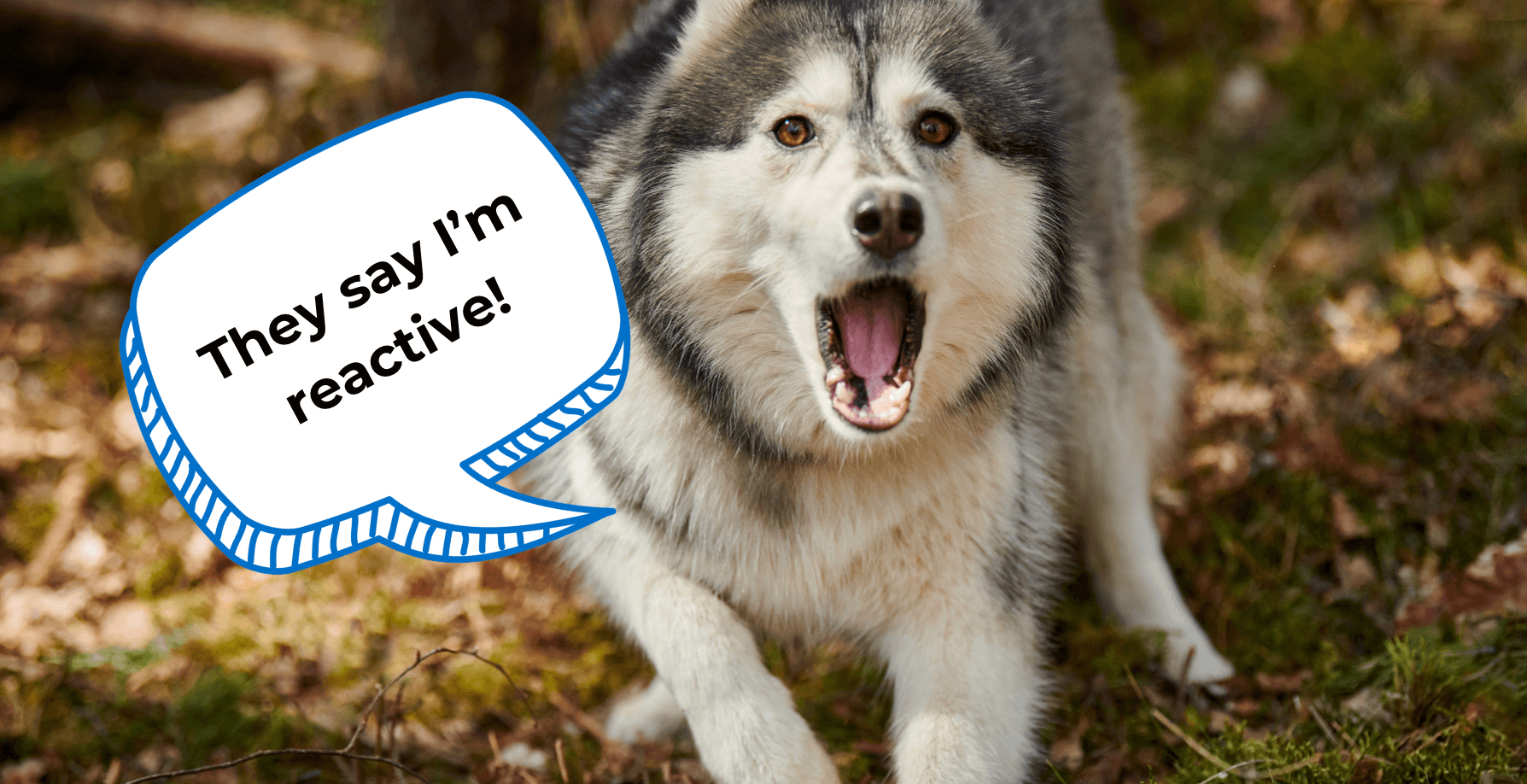
If your dog is a sweetheart one moment and an agitated barker the next, you can be dealing with a reactive dog.
Quick disclaimer: a reactive dog is not always an aggressive dog. Reactivity and aggression look the same, but these behaviors are not alike. Most dogs react to a trigger by barking, growling, and lunging. This behavior is mainly fueled by fear, not the desire to harm or hurt. HOWEVER, a dog with reactivity issues can ultimately be pushed to aggression. This is why I encourage you, as a dog owner, to stop dog reactivity the moment you see the signs.
In this blog, I'm going to share all the crucial information you will need to stop overreactive dog behavior and the best dog reactivity training tips to calm your reactive dog.
This blog explores the underlying causes of reactivity and provides practical tips for training and socializing your dog.
Whether you're dealing with leash aggression, fear-based reactions, or territorial behavior, this comprehensive guide on how to stop dog reactivity will give you the knowledge and tools to help your dog overcome it.
Let's dive in.
Key Takeaways
- Early Socialization Matters: Introduce your puppy to diverse environments, people, and dogs during their critical socialization period to build confidence and reduce fear-based reactivity.
- Positive Reinforcement Is A Powerful Tool: Reward calm behavior around other dogs with treats and praise to reinforce positive associations and diminish reactive responses, fostering a relaxed demeanor.
- To Find a Solution, You Must Know Your Dog's Triggers First: Pinpoint specific triggers that lead to reactivity and gradually expose your dog to controlled, positive interactions with those triggers. Seek professional guidance for personalized strategies tailored to your dog's unique needs.
What is Dog Reactivity?
Dog reactivity refers to an overreaction of a dog to stimuli. Reactive dogs respond to perceived threats more intensely than normal dogs.
(I talk more about reactivity in the video below.)
Let me give you a quick example.
You decide to walk to the park one day, hoping for a quiet time with your dog. Along the way, they see a harmless squirrel. A dog without reactivity issues will ignore and go their merry way.
Not with a dog which has an experience with squirrels stealing their food or agitating them!
Their reaction will be so intense; their dog body language will make them look like they entered into a trance, and there's nothing you can do to make them hear your commands. You'll be forced to stop the walk and take your dog away.
When your dog is in the red zone of reactivity, it's like they've hit the turbo button on their emotions. Suddenly, it's not just barking or jumping – it's a full-blown canine whirlwind. Calming them down becomes a puzzle for pet owners.
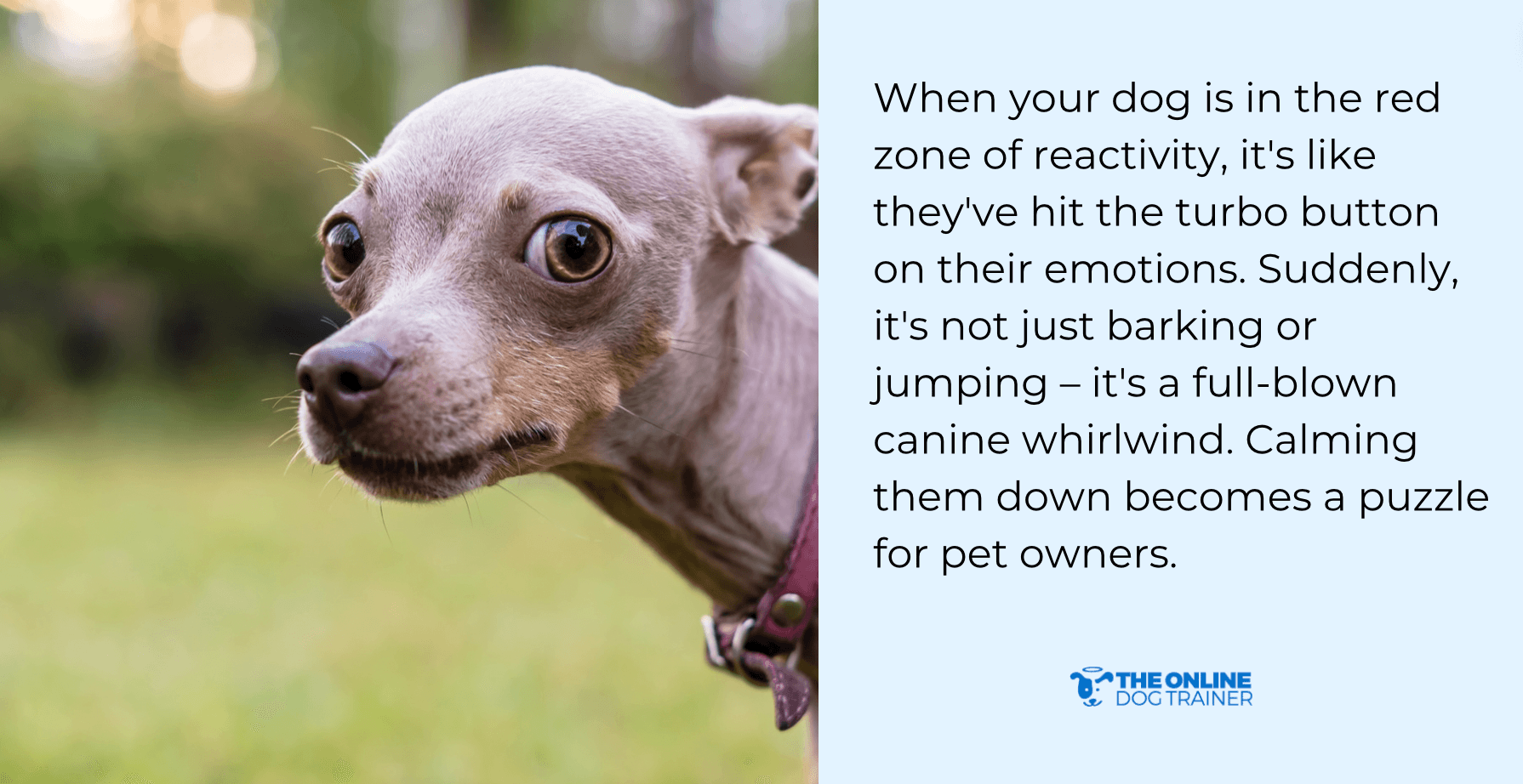
Reactivity isn't just a one-size-fits-all emotion. It can come from fear, excitement, frustration, or a mix of everything.
One thing is for sure, though: a dog struggling with reactivity is so fearful, always on the edge, and deals with emotions so intense they don't know what to do. It's exhausting for them.
A bit of reactivity might initially seem harmless, but let it run wild, and it can become a real issue. Imagine struggling to enjoy a simple stroll with your dog because every encounter becomes a stress-filled saga.
Reactive dogs and their owners often find themselves stuck indoors, missing out on the fun stuff in fear of turning a casual outing into a canine drama.
Dog Reactivity Vs Dog Aggression: What Are The Differences?
What's the difference between a reactive dog vs aggressive dog?
Dog reactivity should be distinguished from dog aggression.
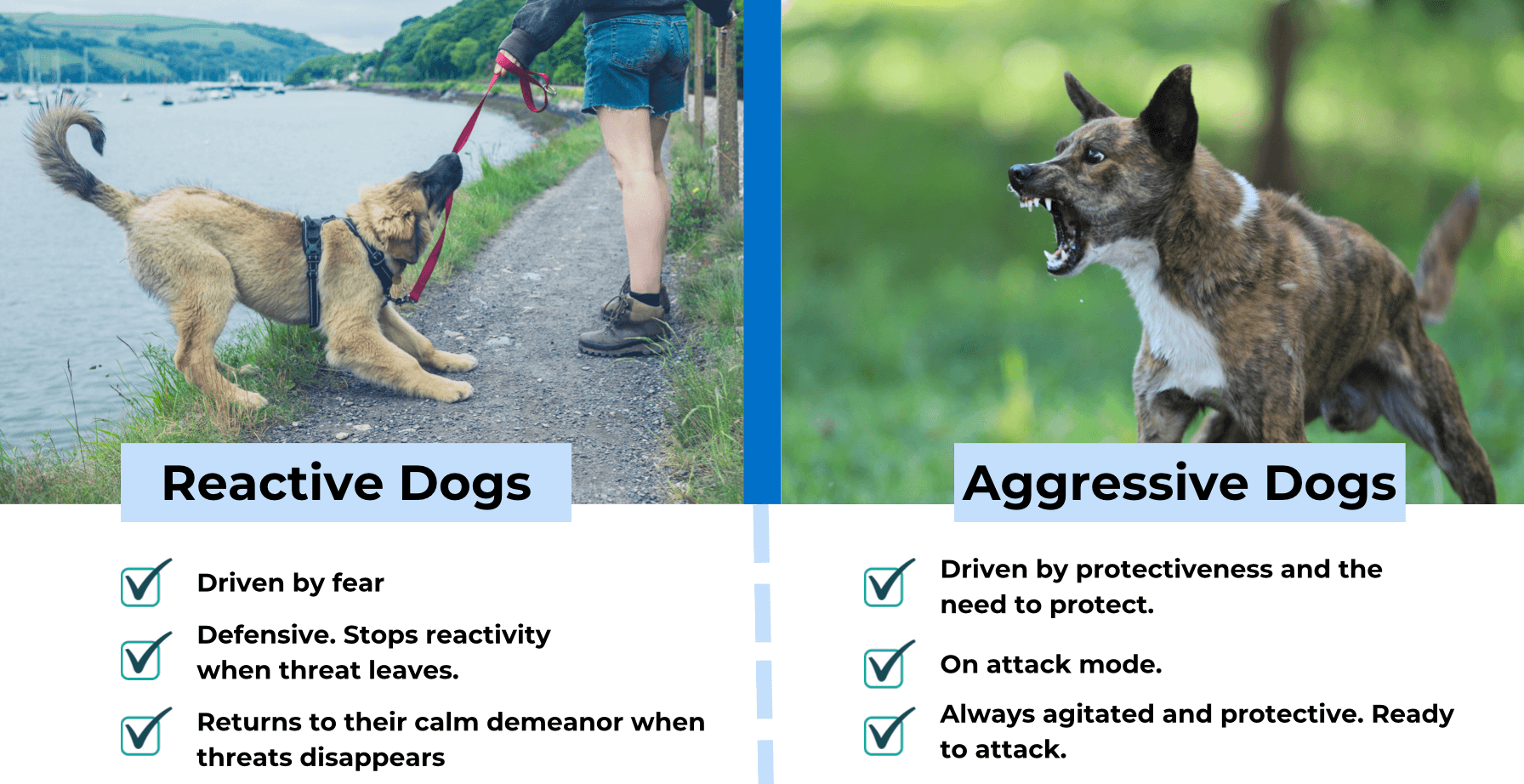
To best explain the difference, here's another example.
Let's say you're expecting friends in your home. They're visiting for the first time, so they're practically strangers to your dog. They get to your doorstep and ring the doorbell.
A calm, relaxed dog will acknowledge the sound but make nothing out of it.
A reactive dog will bark, run around, jump onto you, or scratch on the door. They will bark non-stop, but they don't necessarily have the intent to bite your visitors.
An aggressive dog will not only bark, lunge, or scratch; they're also showing aggressive body language, such as becoming tense and stiff, ready to attack and cause harm.
“But Doggy Dan, can my reactive dog also become aggressive?”
A dog that's reactive can be aggressive when overcome by fear. Dog reactivity triggers the flight and fight response in your dog, so if it feels trapped or helpless, they can resort to aggression.
Understanding Dog Reactivity: What Your Dog Really Needs You to Know
It's a common misconception among owners that dog reactivity is simply an issue with a dog's behavior easily fixed with a few training methods.
Although that is not wrong, I want you to see dog reactivity as not just a behavior issue, but your dog's cry for help.
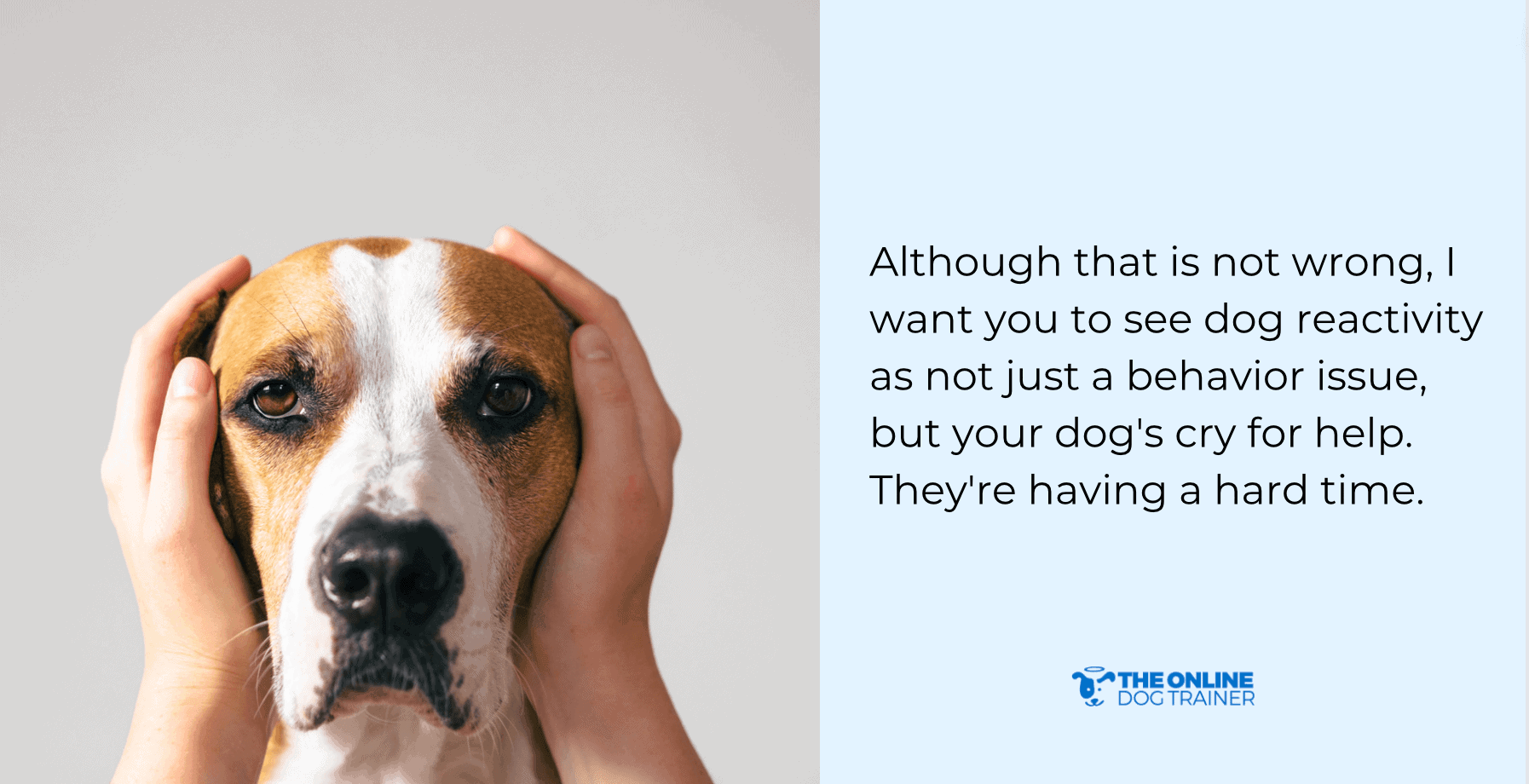
They're having a hard time.
Instead of focusing on “let me change your behavior,” focus on freeing your dog from the mental, emotional, and physical stress that reactivity brings.
Signs of Dog Reactivity
Now that you have a more profound idea of what dog reactivity is, let's talk about the signs that tell you your dog is showing reactive behavior.
Barking and Hiding
Barking is sign #1. Your dog's vocalization and loud noises indicate discomfort, fear, or stress. They use their voice as a communication tool to express a heightened emotion.
Barking is not only a sign of attack but a sign of defense, as well.
When the barking comes with a constant need to hide — even if there's no visible threat — your dog perceives things through a reactive lens.
Growling and Intense Stare
An audible warning sign, growling communicates a dog's unease or displeasure, signaling a potential escalation if stressors persist.
Fixed and intense eye contact may signify a dog's focus on a perceived threat, revealing discomfort or a potential defensive response.
Licking of Lips or Muzzle
This self-soothing behavior can indicate stress, as dogs use licking to calm themselves when confronted with anxiety-inducing situations.
Looking Away
Averting gaze can serve as a calming signal, suggesting a desire to avoid conflict or reduce tension in a potentially threatening situation.
Lunging and Nipping
Your dog's sudden leap forward demonstrates an attempt to increase the distance between them and what they think is a potential threat.
Look for signs that your dog is in defense mode such as nipping and lunging.
Sudden Scratching
A stress reaction, dogs may engage in sudden scratching as a displacement behavior, redirecting their anxiety into a physical action.
Tail Between Legs
A lowered tail indicates fear or submission, reflecting the dog's attempt to make itself appear less threatening in response to a perceived danger.
Dog Reactivity Training: What Causes Reactivity in Dogs
Managing reactive behavior starts with knowing the root cause of dog reactivity, and multiple factors come into play!
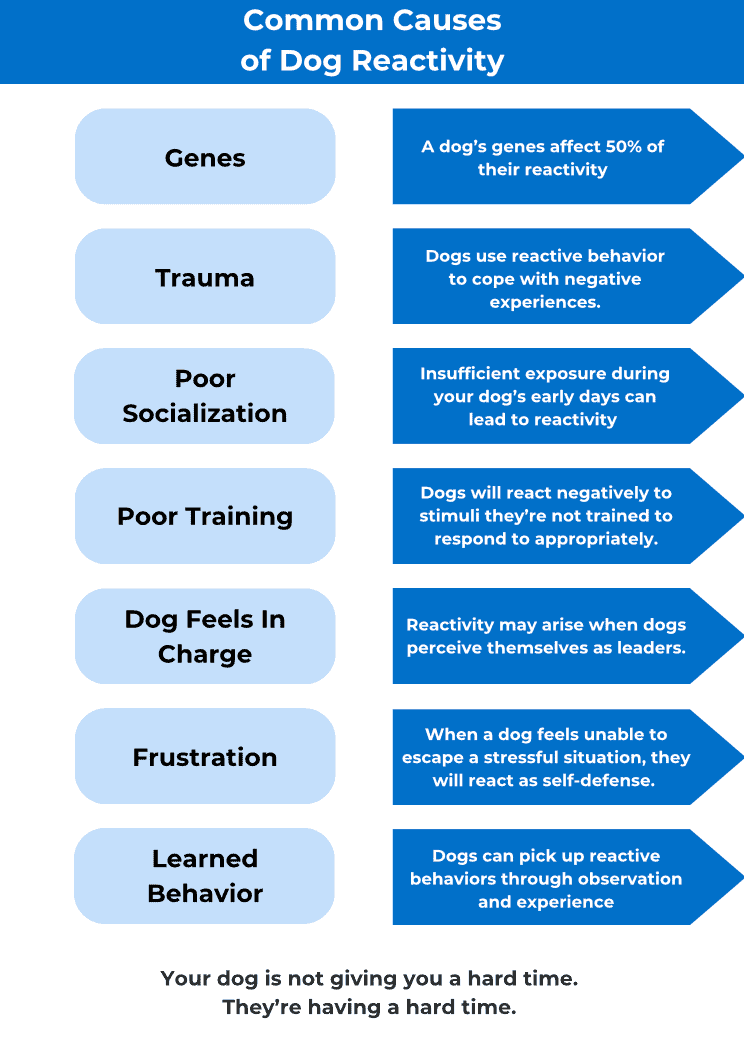
Does Genetics Cause Reactivity in Dogs?
Genetics can be a factor in dog reactivity, although it's not the most defining. In one study, researchers noted that dogs' genes can influence 50% of their fearfulness and energy levels.
Certain dogs or breeds are prone to developing reactive personalities. For example, terrier breeds commonly display reactivity towards other dogs, whereas herding breeds typically show heightened responsiveness to motion, particularly forward movement.
Data-wise, that's good news. 50% is significant, but it doesn't mean genetically predisposed reactive dogs can't improve.
Right training can change dog reactivity, and lacking one can be dangerous. Remember, external stimuli heavily influence dog reactivity.
Below are other factors that cause dog reactivity and why you should consider them when dealing with reactive dog behavior.
Trauma and Past Experiences
Dogs may develop reactive behavior to cope with negative experience or traumatic events.
A dog with a history of physical abuse will be more defensive and panicky than a dog that doesn't have a traumatic past.
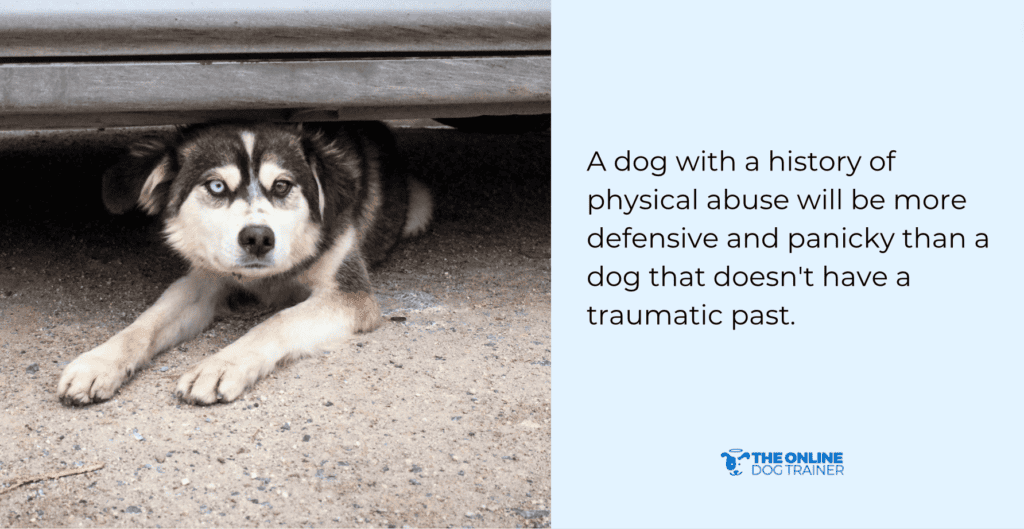
When dogs get all worked up, their brains go on high alert, leading to bouts of anxiety, irritability, and confusion. You might notice them doing weird or repetitive stuff, getting super energetic, or even showing a bit of an aggressive side. It's like their brain hits the turbo button, and things can get a bit wild!
Lack of Socialization and Lack of Dog Reactivity Training
The first 8-12 weeks of your dog's life predict so many things, including whether or not they will be reactive.
Insufficient exposure to diverse environments, different animals, other dogs, and different situations during early development stages may lead to reactivity due to unfamiliarity.
Dogs may also exhibit inappropriate reactions to stimuli if they haven't been adequately trained to respond appropriately. Moreover, a reactive dog that isn't corrected will think there's no problem with being reactive!
Dogs Feel They're In Charge
For most reactivity cases, a dog's reactive behavior arise when dogs perceive themselves as leaders, leading to assertive or dominant behavior.
A dog who cringes at the idea of a threat coming near them, you, or their property may feel that they're in charge.
I will talk more about this topic here.
Frustration
Frustration, particularly when a dog feels unable to escape a stressful situation, can escalate anxiety and potentially result in reactive behaviors. A reactive dog is always on fight-or-flight mode. Take away the flight from their options, and they will be reactive to defend themselves. If your dog is alright off leash but panics when the leash is on, check for signs of frustration.
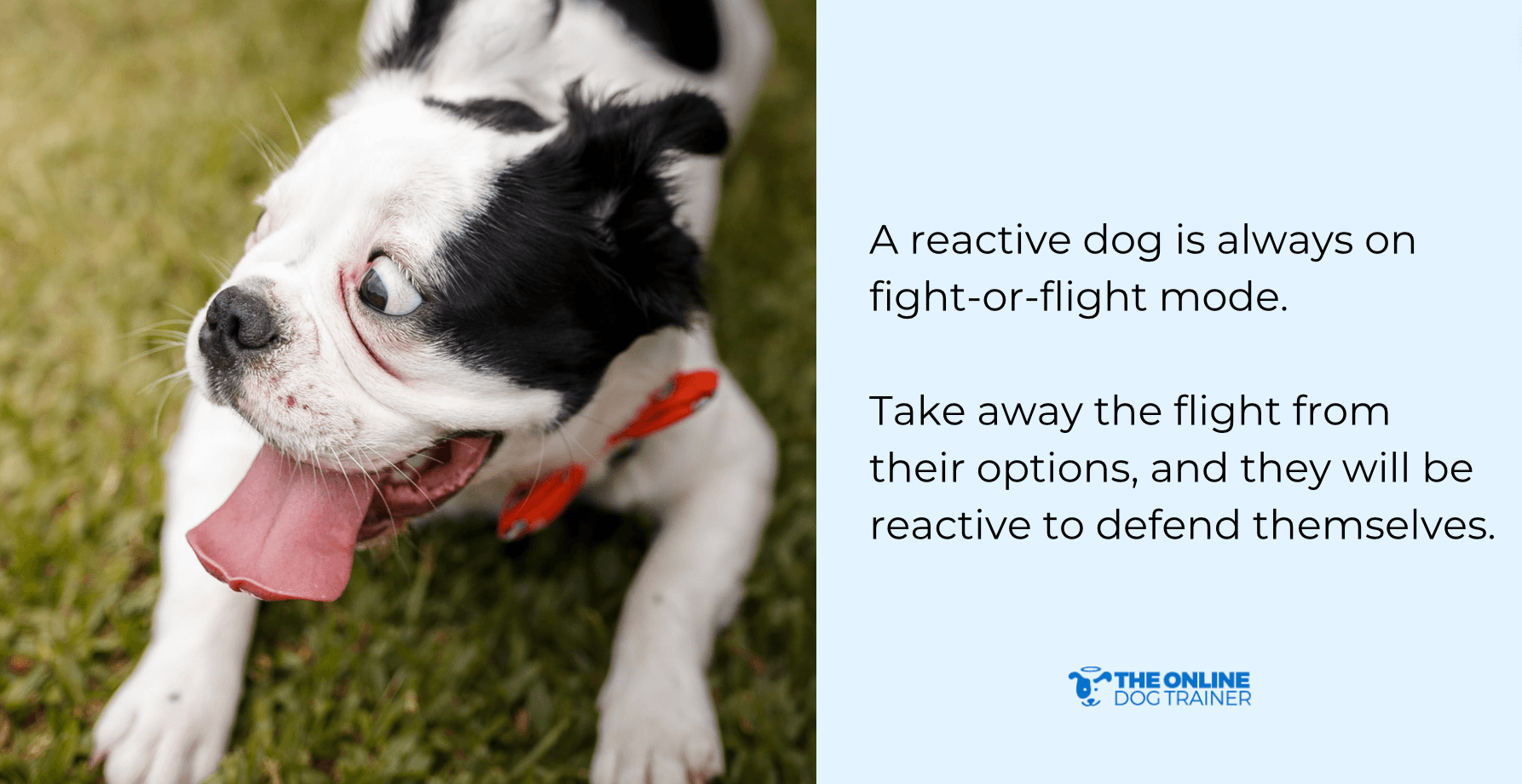
Learned Behavior
Dogs can pick up reactive behaviors through observation and experience, emphasizing the importance of positive reinforcement and proper training to shape desired responses.
Different Types of Dog Reactivity
Leash Reactivity
Leash reactivity is like an involuntary emotional struggle in your dog, triggered by the instinctual fight or flight center in their brains. A leash-reactive dog is one that transforms from absolutely chill to uncontrollable the moment you use the leash. They calm down once the leash is off.
When a dog feels stressed, anxious, excited, scared, or frustrated, they might act out on the leash. This reactive behavior is a reflexive response rooted in those deep emotions.
Constrained by the leash, a dog's stress hormones, like cortisol, shoot up. Because your dog's ability to take “flight” is restrained, they resort to “fight.” Normally, this surge prepares them to escape a threat, but with the leash holding them back, they switch to a defensive “fight” mode.
Fear-based Reactivity
Fear-based dog reactivity is a feeling of apprehension linked to the presence of a person, dog/animal, or specific social or environmental situations. When a trigger is near, reactive dogs can go ballistic and uncontrollable.
When your dog's reactivity stems from fear, they can react terribly to even the most harmless situations. You often see this in dogs who either have a traumatic past or did not receive enough socialization.
For these dogs, danger is associated to certain things.
A dog who was abandoned will panic when they feel they are taken away from you. If they have dealt with violence, any looming figure can trigger a fear response.
Even exposure to unfamiliar dogs can be a trigger!
A fearful dog is often misunderstood as aggressive and harmful. They bark, they are restless, and they sometimes get into a pose that signals — what looks like — an impending attack.
But fear-based reactivity makes the dog go to defensive mode.
They'll try to dodge the situation or send out signals that they're feeling uneasy.
But here's the kicker — if we miss those signals or decide to play the ignoring game, the fearful dog will step up their game. It's like they're saying, “Hey, I'm not comfortable here!”
Dog-to-Dog Reactivity
Though dogs are known for their inherent sociability, they can still show signs of dog-to-dog reactivity.
This kind of reactive behavior refers to a dog's agitated, frustrated, or scared reaction at the sight of another dog.
There are a couple of reasons for this reactivity.
Firstly, some dogs might have missed out on critical socialization during puppy days — when they should have learned the ropes of interacting with dogs of various shapes, sizes, breeds, and ages. Another reason is a negative encounter during their early interactions with another dog or group, continuously making them feel frightened or overwhelmed.
On the flip side, some dogs have had an absolute blast playing with other dogs. Now, the experience can make your dog think every other dog they see is an instant playmate! So, when they can't engage in their expected play session, frustration kicks in, and it will show!
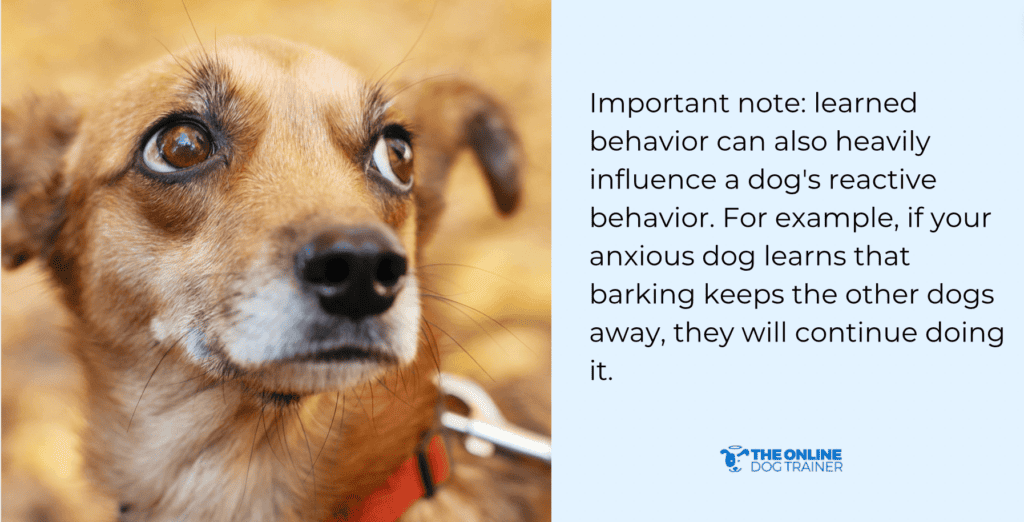
Important note: learned behavior can also heavily influence a dog's reactive behavior. For example, if your anxious dog learns that barking keeps the other dogs away, they will continue doing it.
So, the next time they encounter a dog that makes them uneasy, they might resort to the same strategy, thinking it's a successful defense mechanism. Understanding these when dogs play is vital in helping them navigate social interactions more smoothly.
Reactivity Due to Territorial Behavior
Territorial dog reactivity stems from a protective instinct rather than aggressive intent.
For your dog, space is sacred. When you or another dog steps into their space, they can become very protective.
Territorial and reactive dogs guard their space because they know it's key to their safety and survival.
How to Stop Dog Reactivity: Dog Reactivity Training for a Leash-Reactive Dog
Start Every Walk Calmly
Before heading out, practice capturing your pup's attention by saying their name and rewarding them for looking at you.
Begin in a low-distraction setting, like your living room, and gradually progress to busier areas. This helps your dog learn to focus on you despite the surroundings.
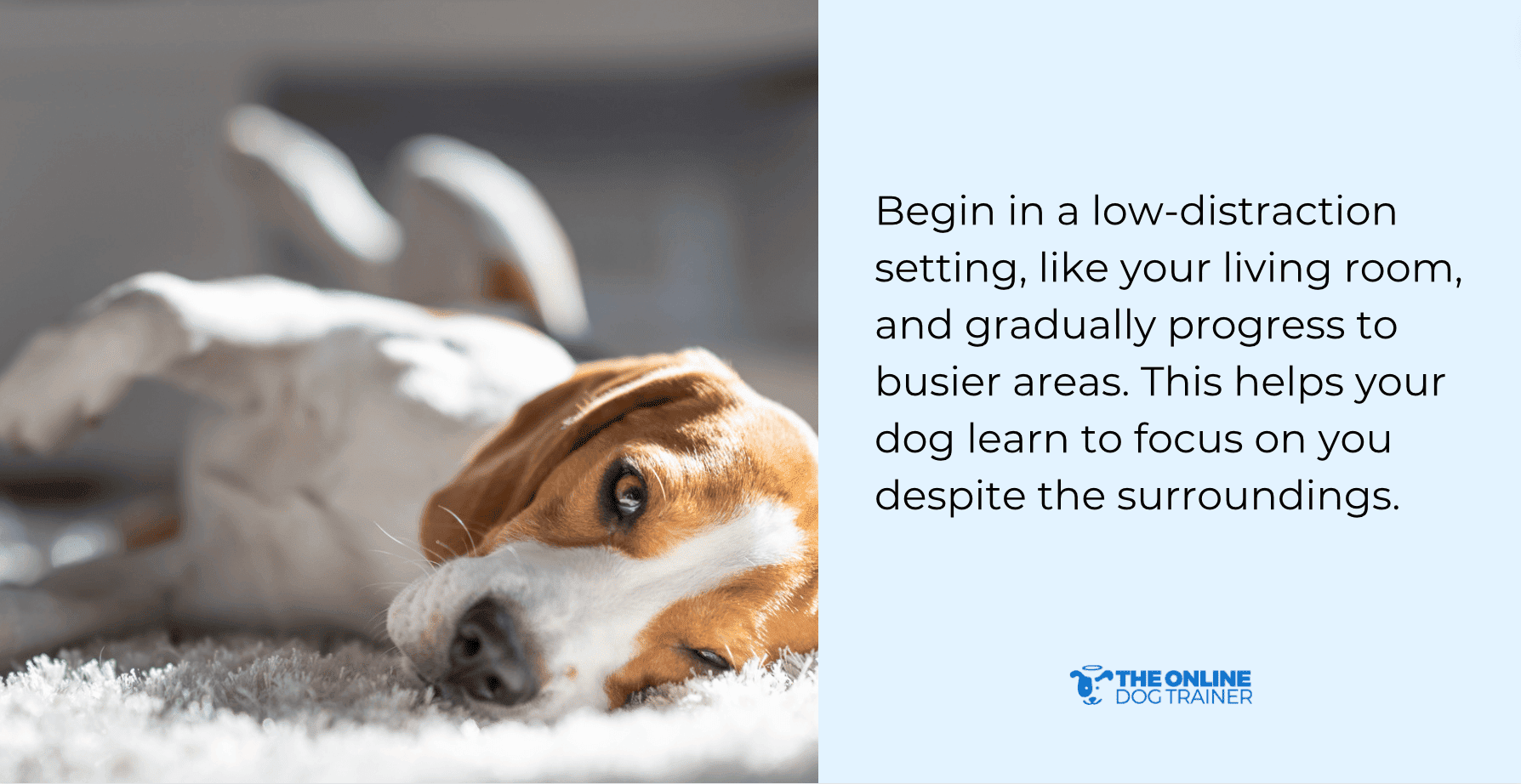
Be Proactive During Walks and Respect Dog Boundaries
When you spot another dog approaching, don't wait for your dog to react.
Get their attention, reward them, and create positive associations. Move closer when they look to you for more reinforcement.
Some owners think it will only encourage more socialization when their playful yet reactive pup is jumping around your dog.
Not with dogs that are anxious and scared!
They can only hold off a little until they start going full-on defensive mode, complete with barking!
If a playful dog is a trigger to your dog, politely tell the owners so you can keep boundaries.
Don't Force Interactions on Dogs While They Are On the Leash, Take It Slow and Adjust
When both dogs are on a tight leash, they are agitated and anxious. When they're forced to interact, they interpret it as a signal to fight. Both will be in defense mode, lunging and barking and pulling the leash. Dog owners think it's bad behavior… but it's often a dog's way of expressing their fear.
If your dog barks or lunges, you may have moved too quickly. Your dog takes on your energy. So when they feel you're worried because of the stressful way you're leading them, your dog will think there's something to worry about.
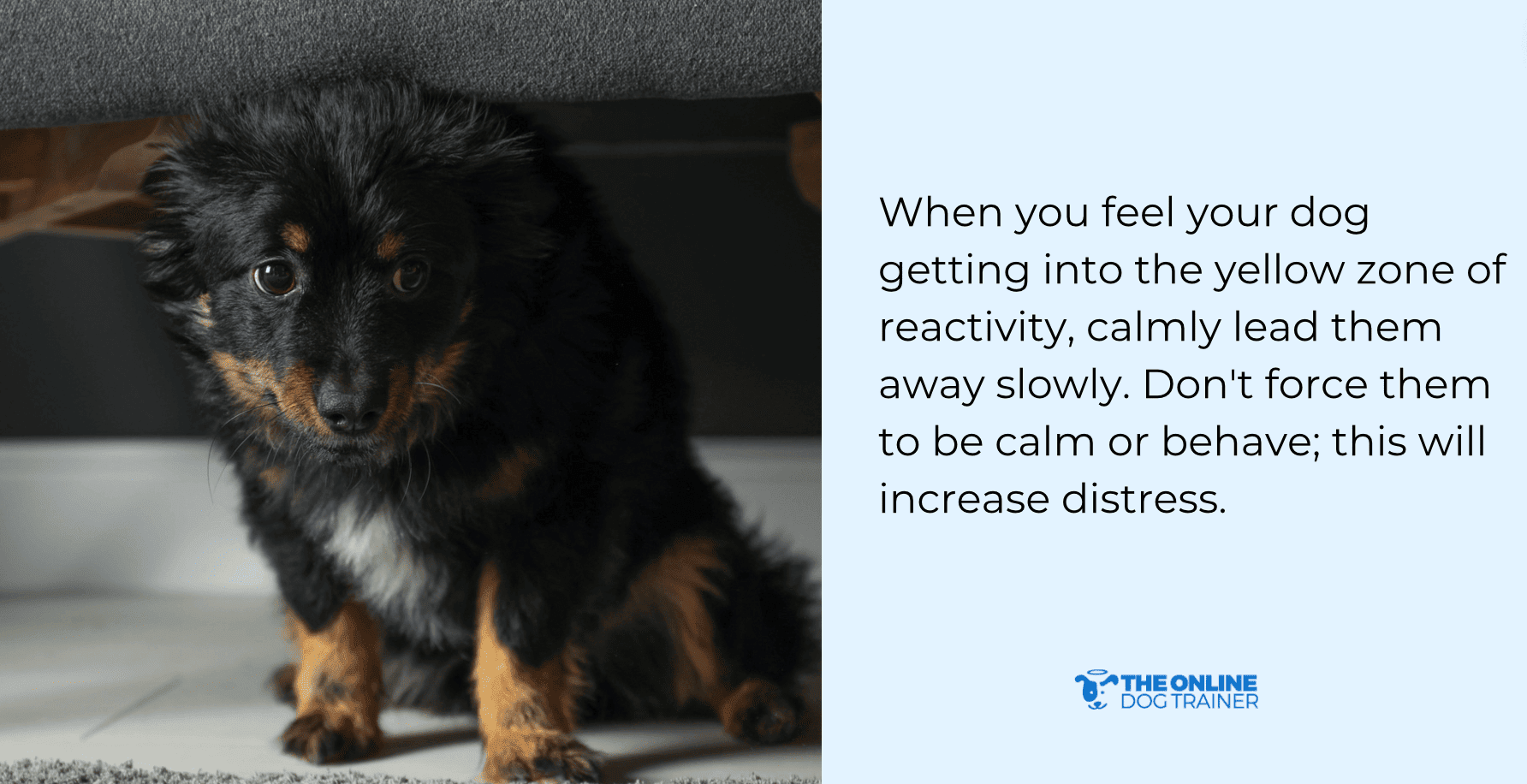
When you feel your dog getting into the yellow zone of reactivity, calmly lead them away slowly. Don't force them to be calm or behave; this will increase distress.
Don't Punish Your Dog or Force Them to Obedience
It's understandable: you only want your dog to learn faster so they can be saved from the stress of dog reactivity.
However, resorting to punishment and fear-based training in the hopes that your dog will learn faster will only backfire. This is why positive reinforcement techniques are needed.
Remember, your reactive pup is triggered by fear! And punishments cause fear!
Ensure a Safe Environment
Manage your dog's space, avoid greetings, and steer clear of negative interactions. A dog's environment matters so choose locations with fewer canines if you're in a dog-heavy area.
Approach Dogs Strategically
Avoid direct head-on encounters; instead, navigate around in an arc while maintaining your dog's attention (this is the proper way for making dogs meet!).
Reward your dog during encounters, and stop treats when the other dog is gone, reinforcing positive associations.
For safety, get a basket muzzle if your dog has a history of harming others.
Dog Reactivity Training: How to Control Fear-based Reactions
Identifying Triggers
The first step is pinpointing the trigger for your dog's overreactive reactions. If your dog reacts easily to a certain stimuli, take note of it.
A trigger is anything that acts as a stimulus, causing your dog to react dramatically. Triggers can be strangers, unfamiliar dogs, or specific situations like someone wearing a hat or walking in a crowded space.
Some dogs may be reactive in all situations, while others only in specific circumstances. A crucial step in reducing reactive tendencies in your dog is to really prevent triggers from overpowering your pet.
Protecting Your Dog
Immersing your dog in uncomfortable situations can worsen their fear and behavior.
Be vigilant when out with your dog, and avoid potential triggers when possible. Scan the area before going out to ensure you won't run across anything that scares your dog.
Give your dog walks and outings where they can relax and be praised for good behavior.
Remember that not all dogs need to be friends with everyone. While outdoors, your dog doesn't have to socialize all the time, especially if it's too stressful for your dog.
Be your dog's advocate, protect them from unwanted attention, and calmly inform others if your dog is working, shy, or in training.
Counter-Conditioning
Avoidance is not a permanent solution.
To see progress in your dog's reactivity, you also need many hours of counter-conditioning to make your dog's triggers less frightening and provide coping strategies for stressful situations.
Counter-conditioning is replacing a negative association with a positive one.
For example, if your dog associates a walk to the park as a stressful event, you can use treats as a way to help your dog disassociate the trip outside with fear.
Always carry treats and reward your dog as soon as a trigger appears.
You can also use toys and compliments to encourage your dog to try going out even if it's scary at first.
Continuous effort is essential. If difficulties arise, consult with a veterinary behaviorist or fear-free dog trainer to tailor strategies for your dog.
Show Your Dog That They Can Trust You
In my experience as a dog trainer, I saw a pattern of reactivity caused by fear: dogs think they're in charge.
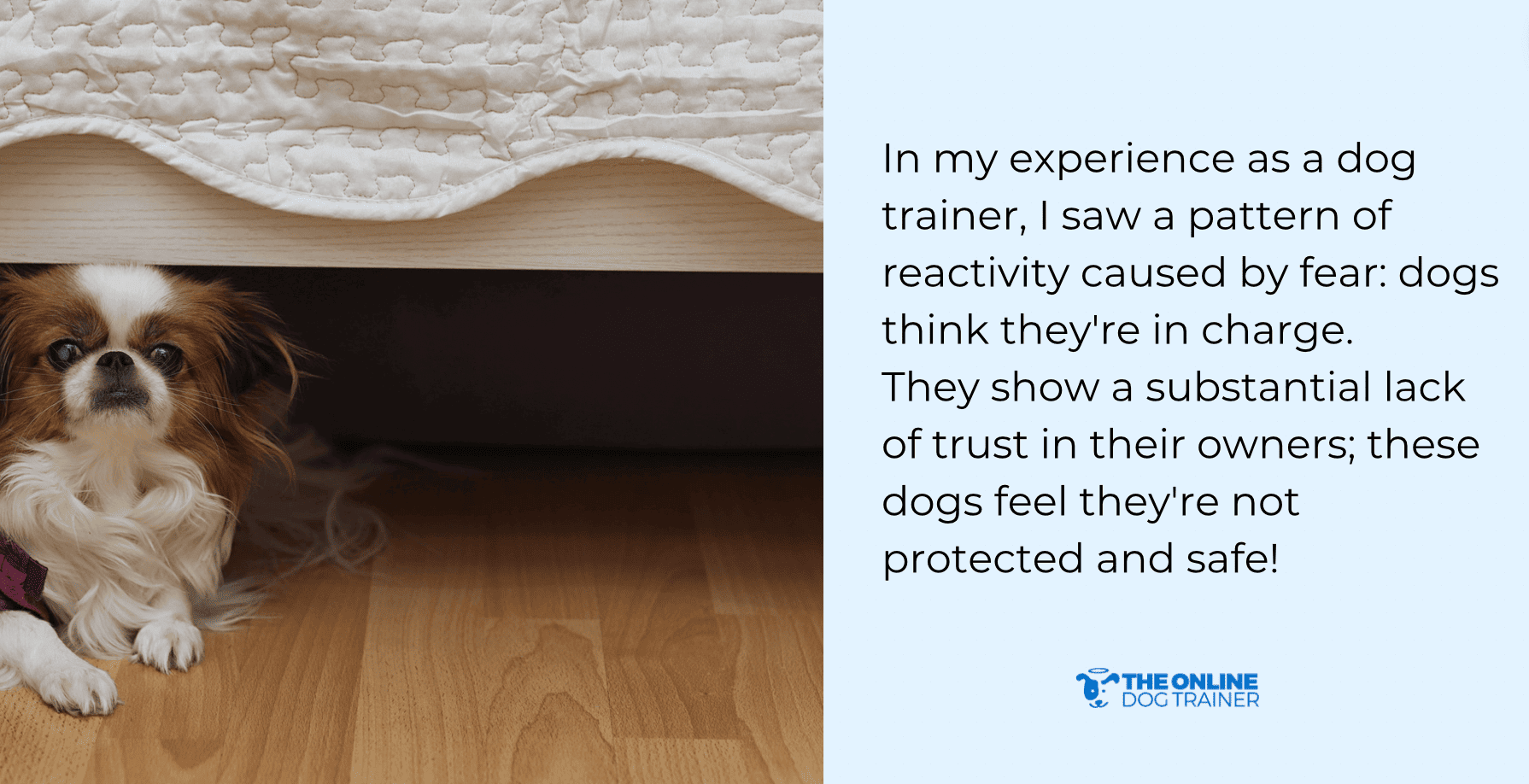
They show a substantial lack of trust in their owners; these dogs feel they're not protected and safe!
Thus, they need to be defensive all the time. An anxious and defensive dog needs an owner they can rely on.
Show your dog that you have control over the situation. Show them you can protect them. Make sure they know you're there to make their safety priority #1!
How to Stop Reactivity: Dog-to-Dog Reactivity Training Tips
When your puppy is around eight weeks, Introduce them to diverse environments, people, and dogs. This critical socialization period helps build confidence and reduce fear-based reactivity.
Walking outdoors is an excellent form of socialization, even for adult dogs. You can also meet up with another dog parent. Remember to keep boundaries and assess your dog's reactivity levels before encouraging them to socialize.
Your dog is potentially reactive because they are protective of you. In a case like this, it's essential to help your dog feel they don't need to protect you. Show them you're the one in charge of danger, not them. Let them know you're the protector, not them.
You can do this by reacting calmly when your dog barks and overreacts because of what they perceive is danger. Learn more about this strategy in my blog.
How to Stop Dog Reactivity from Territorial Behavior
Establish Clear Boundaries with Your Dog and Encourage Positive Exposure
Clearly define your dog's territory through consistent reinforcement of boundaries at home. Use positive reinforcement when they respect designated areas.
Gradually expose your dog to new people, animals, games and dog sports, and environments within their territory. Positive encounters will help them associate these activities with positive experiences. Introduce a dog park if available.
Have Supervised Training Outdoors
Teach commands like “stay” and “leave it” to enforce control over territorial impulses. Consistent training builds a foundation for better behavior within the designated territory.
Monitor outdoor time to ensure your dog's territorial behavior is managed. Create a training plan where leash training and controlled activities can be safely introduced.
Create Safe Spaces
Designate specific areas where your dog can retreat and feel secure. Provide comfort items like beds or toys in these spaces to alleviate territorial stress.
Take Control and Show Your Dog There's No Reason to be Territorial
A dog's reactivity and territorial behavior come from a place of fear and protectiveness. They see a threat that could harm them or you, so they will be out in full anxious mode!
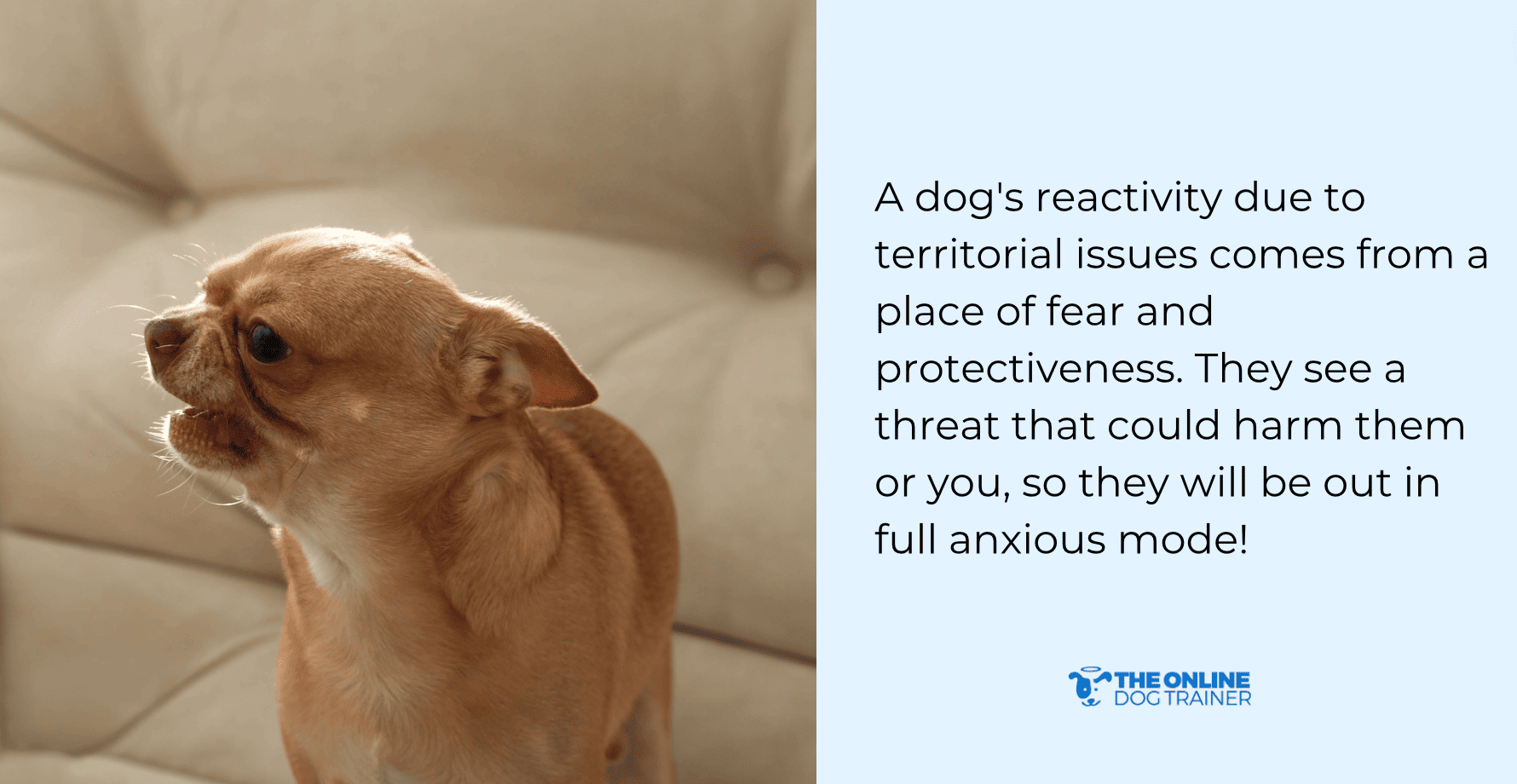
Like I mentioned in the earlier section, your dog must know you're capable of protecting. They need to see you can protect your property and that it's okay if they chill out.
This principle is what I tackle in one of my Five Golden Rules, which you can read here.
6 Ways To Help Calm Your Reactive Dog Down
Show Calm Energy Yourself. Be Mindful of Your Dog's Energy Levels!
I've mentioned this several times in my blogs, but dogs absorb energy… fast! They feel our energy more than they hear our words.
Even if you tell them “Please calm down” but you're energy says otherwise — like, you're anything BUT calm — they will still not calm down.
Focus on being intentional with your energy. Be calm, and let your dog feel it. Let them see you're not worried by anything, so they will feel they can totally rely on you.
This one is very important: you have to take cues from your dog when it comes to dealing with their reactivity.
Don't insist on socializing them if they're showing anxious behavior around other animals. Slowly introduce strangers to them, and hold off if your dog is still not ready. With training, things will improve, but you have to respect your dog's energy, too.
Create a Safe Space Where They Can Retreat and Relax
When things get so overwhelming, make sure your dogs have a spot where they can be uninterrupted. Give them a safe space where they can diffuse stressed and anxious energy so they can calm down easily. Create a safe distance between your dog and the trigger.
Be the Leader They Need
It's in your dog's nature to feel like they're in charge. Dogs are led in packs, and if they don't see any pack leadership in your dynamics, they take on the role as the pack leader, including dealing with danger and being protective of other dogs and you.
The heart of my online training program, The Dog Calming Code, is helping dogs transfer the hat of leadership to you.
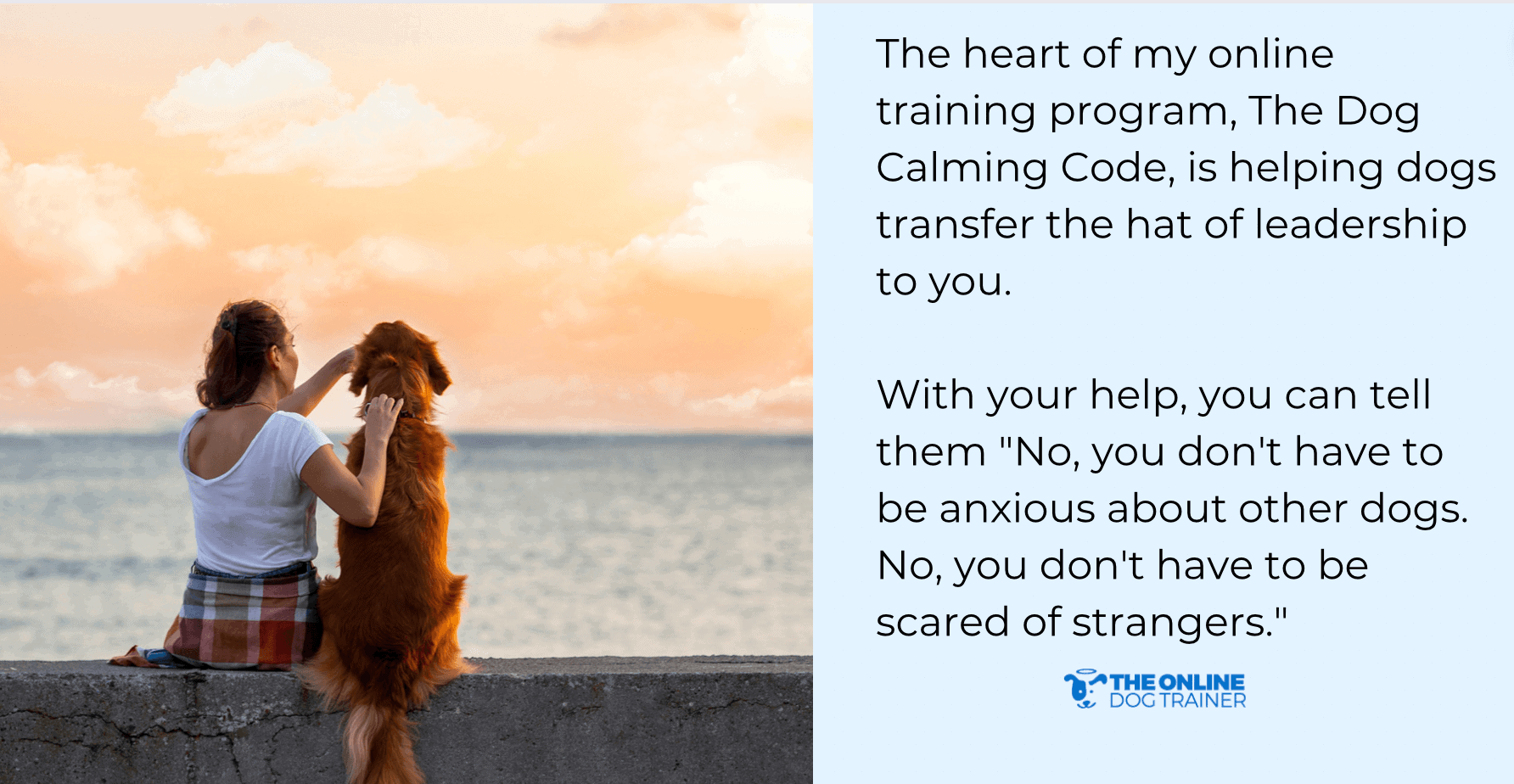
With your help, you can tell them “No, you don't have to be anxious about other dogs. No, you don't have to be scared of strangers.”
Your dogs are fast learners! Once they see your leadership — and how good you are at it — they can learn to slowly calm down.
Take Things Slowly
I know how much you want your dogs to get over their reactive tendencies. To speed up the process, the best way is to go slow. It sounds counterintuitive, I know, but it helps if you train your dog without them feeling stressed and all-over-the-place; something a rushed training can do.
Get The Help of a Trainer
If things remain the same after taking significant steps, don't hesitate to ask for help from a trainer or a trusted professional. Some dogs do have reactive behavior that needs to be escalated to a pro for behavior modification.
Don't Do These If You're Dealing with Reactive Dog Behavior
- In the dog training world, most trainers feel like punishment is a helpful tool. Using punishment is not effective and can make the issue worse.
- reactivity that gets worse
- If the reactivity stems from fear, punishment will only heighten your dog's fearfulness and may even trigger aggression.
- Trying to punish or physically restrain a dog with reactivity issues could escalate their behavior, potentially leading to a bite or a serious attack.
- Same is true if you know your dog will react; do not tighten up on the leash before a person or another dog gets closer. Dogs take this as a signal to fight.
- As their dog owner, it is incredibly important that you'll be there for them once their reactivity elevates. Leaving them out for too long can increase reactivity issues that can be so hard to control.
Seek Professional Help for Reactive Dog Behavior When Needed
If your dog continues to display reactive behavior even with training, don't hesitate to onboard the help of a qualified professional or a dog trainer.
Signs that say you need professional help with your dog:
- persistent reactivity even after you intervene with training
- reactivity that gets worse
- reactivity that has turned to aggression
- signs of extreme anxiety like never wanting to go out, always hiding
Does Dog Reactivity Go Away?
Unfortunately — unlike other quirks that your dog can outgrow of — dog reactivity does not go away on its own. In fact, it is the opposite. When left unaddressed, dog reactivity can worsen and can lead to aggression.
I share more reactive dog training tips here.
You can't just wait for your dog to outgrow reactivity because when your dog isn't trained to deal with triggers properly, the effects of these triggers will only cause more explosive responses.
This is why dog training for dog reactivity is so important!
Are Dogs Less Reactive with Age?
Reactive responses in dogs start to show at around 6 weeks to 18 months. Peak reactive behavior in dogs happen when they're 2 to 3 years old.
Does this mean a dog's reactive responses lessen with age?
Unfortunately, this is still not the case.
Even if signs of reactivity mellow down with age (a senior dog can't bark or lunge as much as an adolescent dog), the reactive tendencies still remain.
You Hold The Key To Helping Your Dog's Reactivity Issue
The number one goal of The Online Dog Trainer is to empower dog owners like you to be active participants in your dog's success. In the training process introduced by the Dog Calming Code, you will find reactive dog training tips so you can bring calm to your dog.
Dealing with dog reactive behavior IS a daunting task; you just want to hand the issue over to a pro.
But, with the right tools, a real change in your dog's disposition starts with you. This has been true for tens of thousands of dog owners who availed of my online dog training program, The Dog Calming Code™️
Learn more about The Dog Calming Code here to see how you can work together with your dog in helping them get over stressful and exhausting dog reactivity issues.




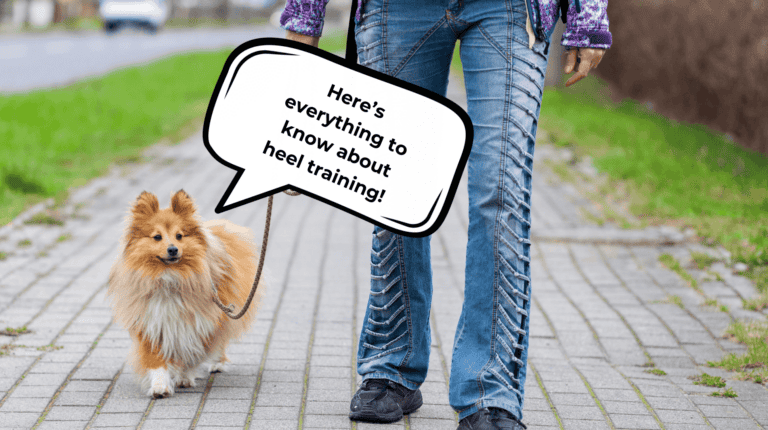
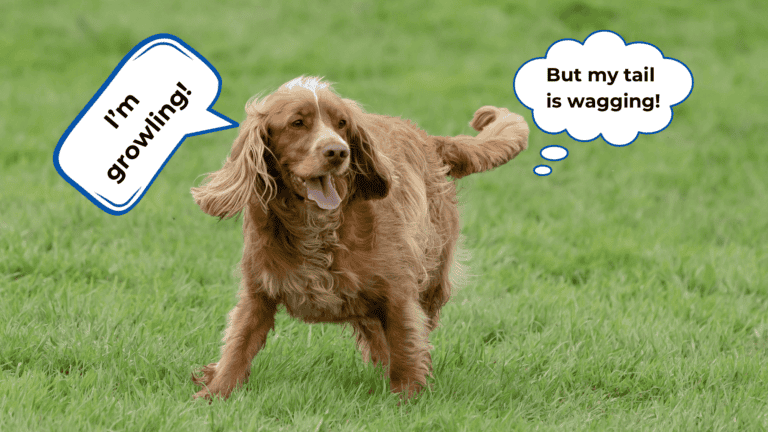
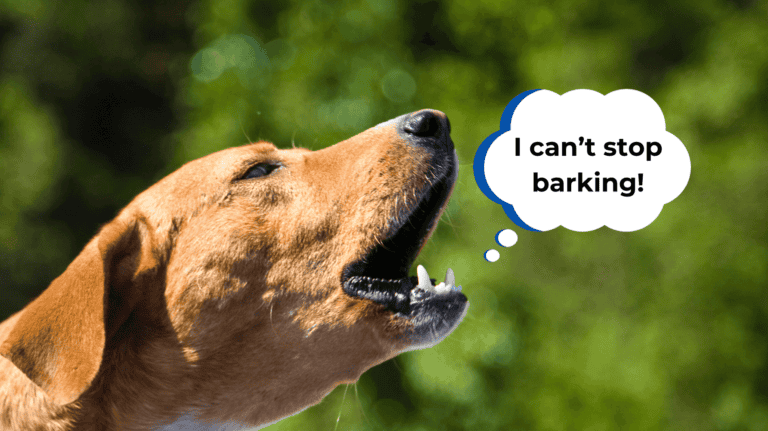

4 Responses
A friend of mine adopted a blind dog who is extremely reactive to any other dog. They live in New York City so it is almost impossible to find quiet spaces without other dogs nearby. She can’t afford a trainer. Your program looks great, do you have advice for working with a scared blind dog??
thanks.
It works exactly the same for a blind dog, with just a few more verbal cues. Get her to check out the free webinar, she’ll love it!
The Reactivity Webinar happens weekly on Wednesday and Sunday at 3pm EST (USA time). The link for the webinar is here, and you can choose this week or the following week: https://theonlinedogtrainer.com/reactivity-webinar/
If you register, you’ll get the recording via email after the webinar
I am interested in your upcoming master-class although given the time zone differences it may not be possible. I see I can watch it later once I’ve registered, I do have a couple of questions that I’d like your perspective on.
1# Best advice on teaching a dog to stay & leave it.
2# Should I be taking my dog out of home environment for walks/ training on ovals even though she doesn’t yet know the leave it/ stay commands? ( on leash at all times.
My dog is definitely fear reactive & unfortunately it’s the ” surprise encounters behind fences” that she is mostly reactive to. She is extremely food oriented & I can keep her attention most of the time when seeing another dog.
If you could please address these questions in your master-class just incase I miss it I would be extremely appreciative.
Regards
Jenny ( South Australia)
Unfortunately I cannot respond to every training question however, if you sign up for the Complete Pack, there’s a forum within the program, which is the best place to post these questions. Our very experienced trainer Hayley will then give you a detailed response. Theres also a lot more training content within. You can get in touch with the help desk to find out more. Cheers Dan